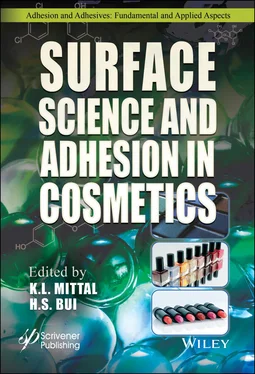11 Chapter 11Figure 11.1 Instability of a thick liquid film on a fiber surface. P Dis the dis...Figure 11.2 An axially symmetric unduloid of a liquid (hexadecane, Θ = 0°) on a ...Figure 11.3 Quadrant profile of the droplet from Figure 11.2. Droplet informatio...Figure 11.4 Clamshell type of unduloids formed on a fiber by a poorly wetting li...Figure 11.5 Hexadecane droplets (1µl) on stainless steel wires of (top-bottom) 5...Figure 11.6 Schematic diagram of the PC-based imaging system.Figure 11.7 (a) Liquid film on a synthetic fiber that undergoes Rayleigh instabi...Figure 11.8 Holding spray on one hair with a load of 1 g showing two droplets co...Figure 11.9 Spray on two parallel hairs with a load of 10 g showing droplet coal...Figure 11.10 Spray on two crossing hairs at a low (a) and 90° (b) angle with a l...Figure 11.11 Spray on three crossing hairs with a load of 10 g. Fibers remain fi...Figure 11.12 Holding spray on a bleached hair. Load = 10 g. We can see droplet c...Figure 11.13 Holding spray on two bleached hair fibers running parallel to each ...Figure 11.14 Holding spray on two bleached hair fibers crossing at an 8° angle. ...Figure 11.15 Holding spray on two bleached hair fibers crossing at a 35° angle. ...Figure 11.16 Shine spray on a bleached hair. Load = 20 g. The surface free energ...
12 Chapter 12Figure 12.1 Contact angle of water droplet on polyester application substrate. A...Figure 12.2 Example of foundation transfer on white fabric (Left) and correspond...Figure 12.3 (Top) Mean water contact angle values for polyester substrate and fo...Figure 12.4 Mean water contact angle values for bio skin substrate and foundatio...Figure 12.5 (Top) Transfer values for foundations films on polyester substrate w...Figure 12.6 (Top) Transfer values for foundations films on polyester substrate w...Figure 12.7 Comparison of the effect of transfer medium on transfer of the four ...Figure 12.8 Transfer values for foundations films on bio skin substrate with art...Figure 12.9 Transfer values for foundations films on bio skin substrate with art...Figure 12.10 Comparison of the effect of medium on the transfer of foundation pr...Figure 12.11 Analysis of shade effect (light and dark shade) for FD1 and FD3 on ...Figure 12.12 Foundation swatches applied to forearm. Image taken after transfer ...Figure 12.13 In vivo transfer values after 4 hr. wear period.Figure 12.14 Comparison for application to polyester substrate with sweat and se...
13 Chapter 13Figure 13.1 Typical Scanning Electron Microscopy images of a dyed hair fiber nea...Figure 13.2 (a) Schematic representation of the capillary fiber. (b) Schematic r...Figure 13.3 FT-IR spectra for black hair fibers after oxidation with H 2O 2for di...Figure 13.4 Loss of lipid layer during damaging process of hair surface.Figure 13.5 AFM images of the standard white hair: (a) virgin fiber and the corr...Figure 13.6 Denaturation temperature of natural and oxidized black hair. N0 and ...Figure 13.7 ζ-Potential of SDS-polyquaternium 6 (PDAC) mixtures as a function of...Figure 13.8 Binding isotherms for surfactants on Polyquaternium 6 as a function ...Figure 13.9 SLES concentration dependence of μ e for Polyquaternium 6 – SLMT mixt...Figure 13.10 Schematic representation of the phase diagram of an arbitrary polye...Figure 13.11 Schematic representation of the aggregation of polyelectrolyte-surf...Figure 13.12 Dependences of the thickness and adsorbed amount on the surfactant ...Figure 13.13 AFM images and their corresponding height profiles for Polyquaterni...Figure 13.14 (a) Acoustical thickness dependence on the dilution factor for the ...Figure 13.15 Illustration of the computational strategy. (a) The adsorption syst...Figure 13.16 Aggregation numbers of the surfactant g p(left ordinate) and polym...Figure 13.17 Radial volume fraction profiles for PQ 6-surfactant composite system...Figure 13.18 Left: Binding isotherms for PQ 6-mRL(C 10and C 14) as PQ 6amount is i...Figure 13.19 Ratio of adsorbed amount of surfactants and polymers for (a) PQ 6-AP...Figure 13.20 Volume fraction profiles of PQ6 and, inset, surfactants for the dif...Figure 13.21 Average height 〈H〉 of each species in the deposits and for all bina...
14 Chapter 14Figure 14.1 Chromatogram for the molecular weight distribution of NAD – 1.Figure 14.2 Particle size distribution for NAD – 1.Figure 14.3 DMA Thermal scan showing storage modulus E’, loss modulus E’’ and da...Figure 14.4 Tan(δ) as function of temperature for the 3 non-aqueous dispersions.Figure 14.5 Tensile stress as a function of elongation for 3 NADs of poly(acryla...Figure 14.6 TEM images of particle deposition on EM grids from NAD – 3 sample. M...Figure 14.7 TEM image of NAD - 3 particles. Automatic thresholding of particle c...Figure 14.8 TEM images of NAD – 2 sample without acrylic acid at two magnificati...Figure 14.9 TEM images of NAD – 1 sample (without acrylic acid) at two magnifica...Figure 14.10 Top: 5 µm × 5 µm surface topography images acquired with atomic for...Figure 14.11 Top: 5 µm × 5 µm surface elastic modulus images acquired with atomi...Figure 14.12 Top: 5 µm × 5 µm surface adhesion force images acquired with atomic...Figure 14.13 Water Contact Angles of NAD films at 10 s (left) and 120 s (right).Figure 14.14 Contact angles of artificial sebum droplets on 3 NAD films deposite...Figure 14.15 (a) Evaluation of olive oil (left) and water (right) resistances on...Figure 14.16 In-vivo evaluation of formulations containing NAD - 1 and NAD - 2.Figure 14.17 (a) Monomers and (b) Reaction Scheme for non-aqueous dispersion, NA...
15 Chapter 15Figure 15.1 (a) Visual appearance and (b) TEM picture of iron oxides (red) C.I.:...Figure 15.2 (a) Visual appearance and (b) TEM picture of iron oxides (yellow).Figure 15.3 (a) Visual appearance and (b) TEM picture of iron oxides (black).Figure 15.4 Chemical structures (top panel) and photographs (bottom panel) ofFigure 15.5 The 3 fundamental steps of pigment dispersion.Figure 15.6 Generic metal oxide or organic pigment.Figure 15.7 Use of dispersants and steric or charge repulsions to stabilize pigm...Figure 15.8 Effect of glyceryl caprylate on dispersions of iron oxides in a lips...Figure 15.9 Compatibility studies of surface treated yellow iron oxides with mul...Figure 15.10 (a) Hegman gauge test on yellow iron oxides dispersion, (b) drawdow...Figure 15.11 SEM images of (a) Agglomerates of Aerosil 200 particles, (b) Aggreg...Figure 15.12 Functionalization/surface treatment of pyrogenated silica.Figure 15.13 SEM images of (a) Nylon 12 and (b) PMMA particles.Figure 15.14 (a) Thermal expansion scheme, (b) SEM image of Acrylonitrile/Methyl...Figure 15.15 (a) Synthetic amorphous silica from AGC Si Tech (Solesphere series)...Figure 15.16 (a) Lauroyl lysine and (b) aluminum starch octenylsuccinate particl...Figure 15.17 Compact powder made with perfluorooctyltriethoxy caprylylsilane (Ex...Figure 15.18 Examples of Kobo’s liquid dispersions of ITT surface treated Lake p...Figure 15.19 Example of long-wear formulations made with a polyhydrogenated poly...Figure 15.20 Pictures of lips of panelists wearing formulations containing ASG p...Figure 15.21 Conventional nail polish manufacturing schematic.Figure 15.22 Nitrocellulose based dispersions drawdowns of (a) 2 forms of titani...Figure 15.23 Staining phenomenon observed on nails (a) Stained nail with Blue 1 ...Figure 15.24 TEM pictures of (a) Sensient Black 2 particles and (b) Daito Black ...Figure 15.25 SEM picture of an eyelash onto which carbon black containing long-w...
16 Chapter 16Figure 16.1 Structure of human skin.Figure 16.2 A survey of formulation types of 149 recently launched foundations i...Figure 16.3 Pigmented solutions (20 wt% MQ resin, 1 wt% Red 7 pigment, and 79 wt...Figure 16.4 Images of water and oil droplets on substrates of titanium dioxide. ...Figure 16.5 Viscosity of dispersions of untreated and treated titanium dioxides....Figure 16.6 Water contact angles (top images) and micrographs (bottom images) of...Figure 16.7 Structure illustration of an MQ resin.Figure 16.8 T-Propyl silsequioxane resin with loose cage structures such as in (...Figure 16.9 Illustration of two types of silicone acrylates. Left: acrylate poly...Figure 16.10 Chemistry of preparing trimethylsiloxysilicate/dimethiconol crosspo...Figure 16.11 Chemical structures of four silicone emulsifiers. Top Left: PEG/PPG...Figure 16.12 SEM images showing filler morphology. Left : Nylon-12 particles from...Figure 16.13 Film tackiness of MQ resin and PEG/PPG-18/18 dimethicone (Silicone ...Figure 16.14 Sebum and water contact angles on MQ resin and PEG/PPG-18/18 dimeth...Figure 16.15 Film hardness and tack. a): Pendulum film hardness measurement on b...
Читать дальше












